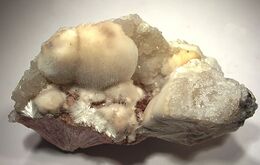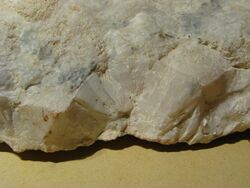Chemistry:Xonotlite
| Xonotlite | |
|---|---|
 Combination piece with radial fibrous inesite and xonotlite | |
| General | |
| Category | Inosilicates |
| Formula (repeating unit) | Ca 6Si 6O 17(OH) 2 |
| Strunz classification | 9.DG.35 |
| Dana classification | 66.3.1.1 |
| Crystal system | Monoclinic |
| Crystal class | Prismatic (2/m) (same H-M symbol) |
| Space group | P2/a |
| Unit cell | 879.33 |
| Identification | |
| Color | White, grey, pale pink, lemon white, colorless |
| Cleavage | Perfect, Good |
| Fracture | Splintery, tough |
| Mohs scale hardness | 6.5 |
| |re|er}} | Vitreous, silky, pearly |
| Streak | White |
| Diaphaneity | Transparent, translucent |
| Specific gravity | 2.70 – 2.72 |
| Density | Measured: 2.70 – 2.72 Calculated: 2.71 |
| Optical properties | Biaxial (+) |
| Refractive index | nα = 1.583 nβ = 1.585 nγ = 1.595 |
| Birefringence | 0.012 |
| 2V angle | 50° |
| Ultraviolet fluorescence | Short UV = weak gray-white Long UV = weak white |
| Common impurities | Fe, Mn, H2O |
Xonotlite, or eakleite, is a mineral of general formula Ca
6Si
6O
17(OH)
2 named by the German mineralogist Karl Friedrich August Rammelsberg in 1866. The name originates from its discovery locality, Tetela de Xonotla, Puebla, Mexico. Although it was discovered in 1866, it was first described in 1959. It is approved by the IMA, but it is a grandfathered species, meaning the name supposedly represents a valid species til this day.[2]
Properties
Xonotlite is an ino-silicate with double dreier chains, of which several polytypes are known. The known polytypes are Ma2bc, Ma2b2c and M2a2bc. It is a mineral related to the tobermorite group. It can be colorless, gray, light gray, lemon white, or pink. It is transparent with a vitreous to silky luster. It leaves a white streak. Xonotlite is rated 6.5 on the Mohs scale of hardness. It crystallizes in the monoclinic – prismatic crystal system,[2] with typically an acicular crystal form or habit, meaning it occurs as needle-like crystals. It is massive, meaning individual crystals are hard to tell apart as they form large masses. It mainly consists of oxygen (42.52%), calcium (33.63%) and silicon (23.57%), and includes hydrogen (0.28%). It is a luminescent mineral, under short ultraviolet light it has a weak gray-white fluorescence, and under long UV it is weak white. It is not a magnetic mineral, and is not radioactive.[3]
Environment and mining
It occurs as veins in serpentinite and contact metamorphism aureoles.[3] Associated minerals include apophyllite, diopside, stilbite, tobermorite, clinohedrite, thaumasite, laumontite and wollastonite.[4] The most common impurities include iron, magnesium and carbon dioxyde (CO
2) impurities. It has many type localities, the most notable one being Tetela de Ocampo, Mexico.[2]
See also
- Chemistry:Gyrolite – Rare phyllosilicate mineral crystallizing in spherules
- Chemistry:Tacharanite – Calcium aluminium silicate hydrate mineral
- Chemistry:Tobermorite – Inosilicate alteration mineral in metamorphosed limestone and in skarn
References
- ↑ Warr, L.N. (2021). "IMA–CNMNC approved mineral symbols". Mineralogical Magazine 85 (3): 291–320. doi:10.1180/mgm.2021.43. Bibcode: 2021MinM...85..291W.
- ↑ 2.0 2.1 2.2 "Xonotlite". https://www.mindat.org/min-4343.html.
- ↑ 3.0 3.1 "Xonotlite Mineral Data". http://webmineral.com/data/Xonotlite.shtml#.YYlE3prMKHs.
- ↑ "Xonotlite". Mineral Data Publishing. 2001. https://rruff.info/doclib/hom/xonotlite.pdf.
Further reading
- Taylor, H. F. W. (June 1959). "The transformation of tobermorite into xonotlite". Mineralogical Magazine and Journal of the Mineralogical Society 32 (245): 110–116. doi:10.1180/minmag.1959.32.245.03. ISSN 0369-0148. Bibcode: 1959MinM...32..110T.
External links
 |


